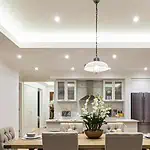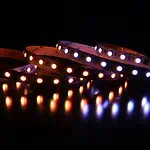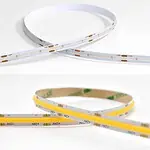Choosing between warm and cool lights can get tricky while lighting up your space. Where warm lights are preferred for bringing coziness, cool lights are well-known for providing an energetic atmosphere. But which of these two is best and why?
Warm and cool lights are categorized based on the color temperature of the light. Lower color temperature (2700K-3200K) gives a yellowish tone, so they are called warm lights. These lights provide cozy candlelight or sun-kissed effects. In contrast, cool lights have a higher color temperature (4000K-6500K), forming bluish with illumination. These lights create an energetic mood which is ideal for task lighting. However, you must consider the application aspects to choose between warm and cool lights.
No worries, this article will explore the differences between warm and cool light. And assist you in deciding which is best for your needs. So, read on to learn everything you need about warm vs. cool light.
Warm Light vs. Cool Light: The Basics
Before knowing about warm and cool lighting, you must know what color temperature is and how it relates to warm and cool lighting.
What is Color Temperature?
Color temperature refers to the hue of the light emitted by a light source, measured in degrees of Kelvin (K). The color temperature scale ranges from warm colors. Such as orange and yellow, to cool colors like blue and white. Warm light has a lower color temperature and appears yellowish-orange. Cool light, on the other hand, has a higher color temperature and appears bluish-white.
Cool light with higher color temperature can make colors appear brighter and more vibrant. At the same time, warm light with lower color temperature can make colors appear more subdued and muted.
Range of Color Temperature
| Lighting Effect | Color Temperature |
| Warm Light | 2700K-3200K |
| Neutral White Light | 3200K-4000K |
| Cool Light | 4000K-6500K |
For more information, you can read
Understanding the Differences Between 4000K and 5000K LED Color Temperatures.
2700K VS 3000K: Which One Do I Need?
3000K vs 4000K: Which Type of Lighting is Good For Home?
What Is Warm Light?
Warm light typically has a color temperature of 2700K-3200K. It appears more yellow or orange in tone, mimicking the warm glow of a sunset or candlelight. Also, it creates a cozy and inviting atmosphere. Warm lights are often used in residential settings or areas where people want to relax. It can be bedrooms or living rooms. Here are some pros and cons of using warm lights-
| Pros | Cons |
| Creates a cozy and inviting atmosphere Helps to reduce eye strain and fatigue Mimics the warm, natural glow of firelight Enhances the appearance of skin tones Can promote relaxation and restful sleep | Can make colors appear less vivid May not provide sufficient light for certain tasks Can make spaces appear smaller and more confined May not be ideal for workspaces or areas where visual clarity is crucial Can give off a yellowish tint that some people find unappealing or unnatural |
Characteristics of Warm Light
- Warm light includes a yellowish-orange hue. They are similar to the color of candlelight or the setting sun. This type of light has a lower color temperature than daylight. This gives it a softer and more calming effect.
- Warm light is less harsh and more diffused than cool white or daylight. This makes it an excellent choice for creating a soothing and inviting environment.
- Warm light produces soft shadows and a warm glow, flattering people’s faces and objects in a room.
- Another characteristic of warm light is that it can enhance the warmth and richness of colors. Thus making them appear more vibrant and natural. This is because warmer light has a higher red content. This can bring out warm tones in objects and surfaces.
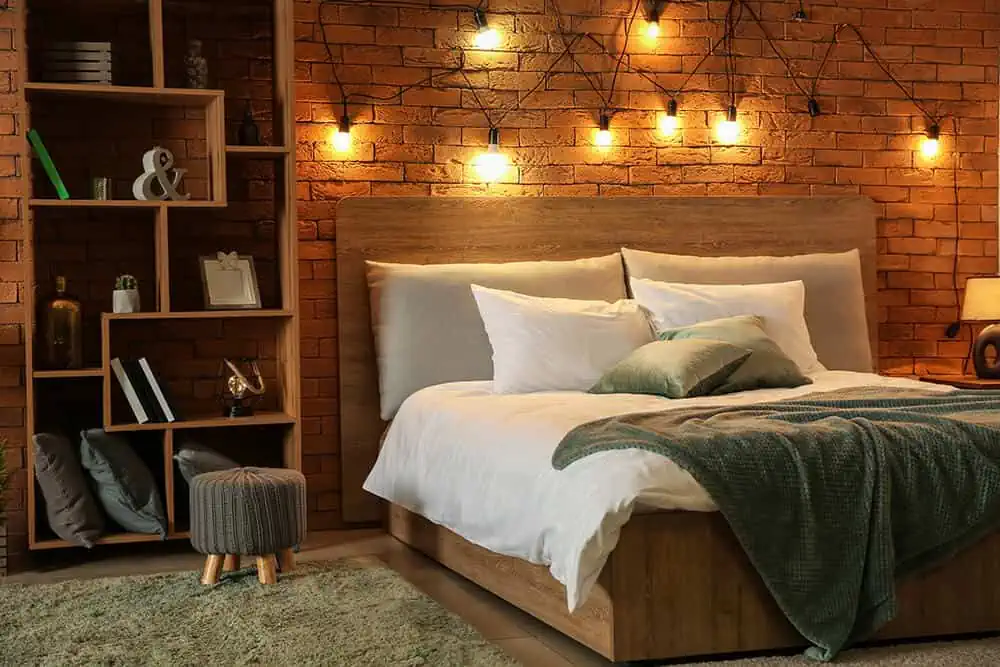
The Benefits of Using Warm Light
Warm light has several benefits over cool or daylight-colored light sources.
- Promotes Relaxation and Comfort
Warm light has a calming effect on our bodies and minds. Thus making it an ideal choice for spaces where we want to feel peaceful and comfy. Like in bedrooms or living rooms.
- Enhances Ambiance and Mood
Warm light creates an inviting atmosphere. This makes it popular in restaurants, cafes, and other hospitality settings.
- Improves Sleep Quality
Exposure to cool or blue-toned light in the evening can disrupt our natural sleep-wake cycle. This can lead to poor sleep quality. In contrast, warm light in the evening can help us wind down. It also helps to prepare for sleep, leading to better sleep quality.
- Flatter Skin Tones
Warm light can make our skin look healthier and more natural. It brings out warmer tones in our complexion. This is why many makeup artists and photographers prefer warm light.
- Saves Energy
Warm light sources such as LED bulbs can be more energy-efficient than daylight-colored ones. Thus requiring less energy to produce the same amount of light.
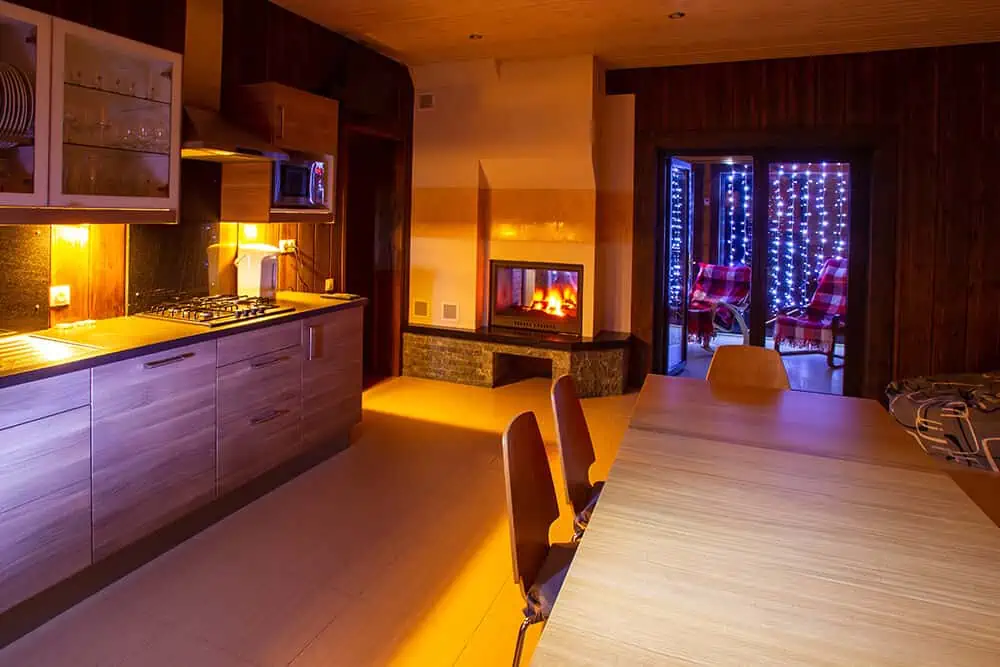
How Warm Light Affects Our Mood?
Warm lighting creates a calming atmosphere that lifts up your mood. That is why these lightings are suitable for areas where you can rest- bedroom, living room, common room, etc. Besides, warm light helps your body relax as part of your natural circadian rhythm. That is why these lights are ideal for creating a good sleeping atmosphere. Additionally, the yellow tone of these lights gives you a welcoming environment. This makes warm lighting suitable for hotel and restaurant lighting.
When to Use Warm Light?
There are several instances where warm light may be the preferred choice. For example, warm light can create a relaxed environment in residential settings. Warm lights can also be used in restaurants, bars, and cafes. Hence it creates a welcoming and intimate atmosphere.
Another situation where warm light may be preferred is in photography and videography. Warm light can add a flattering and natural-looking glow to portraits. It creates a soft and romantic atmosphere in wedding or event videos.
However, it’s important to note that warm light may not be suitable for all situations, for example, in commercial or industrial settings. In this place, brightness and clarity are more important than ambiance. Cool white or daylight bulbs may be more appropriate for these places. Additionally, warm light may not be ideal for tasks that require visual clarity and precision. For example, reading or working on a computer.
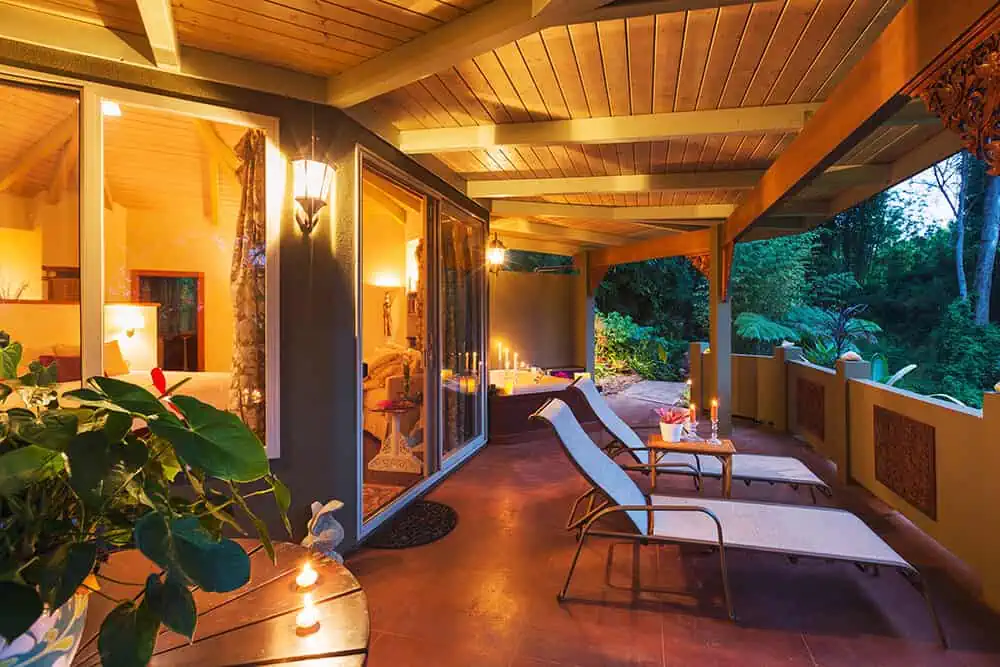
What Is Cool Light?
Cool light typically has a color temperature of 4000K-6500K. It appears more blue or white in tone, mimicking the light of daylight or an overcast sky. It creates a bright, energizing atmosphere and is often used in commercial settings. For example, people must be alert and focused in offices or retail spaces. Here are some pros and cons of cool lighting-
| Pros | Cons |
| Brighter and crisper light Increases alertness and productivity Ideal for task-oriented work Can make a room appear larger Reduces the appearance of yellowing or discoloration Energy-efficient and long-lasting Enhances visual acuity and detail perception | Can create a cold or sterile environment May cause eye strain or headaches Can make color appear washed out May not be suitable for relaxing or calming environments May not be suitable for people with certain health conditions or sensitivities |
Characteristics Of Cool Light
- Cool lighting emits a bluish-white or white light with a temperature of 4000K-6500K. It is a higher color temperature than warm light. This gives it a more blue or white appearance.
- This type of lighting is often used to create a modern, clean look and to enhance contrast and visibility. Cool light can also improve productivity and focus in work environments. It is associated with higher levels of alertness and wakefulness.
- In terms of energy efficiency, cool light is often more efficient than warm light as it requires less energy to produce the same brightness level. It is also commonly used in LED lighting, known for its long lifespan and low energy consumption.
The Benefits of Using Cool Light
Some benefits of using cool light include:
- Increased Alertness and Productivity
Cool light has been shown to improve cognitive performance and increase alertness. Making it ideal for use in workplaces and study areas.
- Improved Visual Clarity
Cool light can enhance visual clarity, making it easier to see details and colors. This can be particularly useful in settings such as art studios and hospitals. Also, you can use it in manufacturing plants where accurate color perception is essential.
- Energy Efficiency
Cool light sources, such as LED bulbs, consume less energy than traditional incandescent bulbs. It can result in lower electricity bills and a reduced carbon footprint.
- Longevity
Cool Light LED sources have a longer lifespan than traditional bulbs. This means less frequent replacement and maintenance costs.
- Security
Cool light can also be used to enhance security in outdoor settings by providing better visibility at night. Deterring intruders and making it easier to identify potential hazards.

How Cool Light Affects Our Mood?
Cool light, also known as blue light, has been found to affect our mood in several ways. Studies have shown that exposure to cool light, especially in the evening or at night, can disrupt our circadian rhythm. This 24-hour cycle regulates sleep-wake patterns, hormone secretion, and other physiological processes.
One of the main ways cool light affects our mood is by suppressing melatonin production. It is a hormone that helps us fall asleep and stay asleep. Our brain interprets it as daylight when exposed to cool light and inhibits melatonin secretion. It can be from electronic devices such as smartphones, tablets, and computers. This can lead to difficulty falling asleep, disrupted sleep, and daytime drowsiness. Thus negatively impacting our mood and cognitive performance.
Moreover, cool light has been linked to an increased risk of depression. Particularly in people already predisposed to the condition. A study published in the journal Nature found that exposure to blue light increased activity in the part of the brain that is associated with depression. Leading to a greater risk of developing depressive symptoms.
On the other hand, exposure to natural light has mood-boosting effects, especially in the morning or early afternoon. Natural light helps regulate our circadian rhythm and promotes the production of serotonin. This neurotransmitter contributes to feelings of well-being and happiness. And it can help alleviate symptoms of seasonal affective disorder (SAD).
When to Use Cool Light?
One of the most common applications of cool light is in work environments such as offices, laboratories, and factories. This can help improve focus and productivity. Cool light can also benefit areas requiring detailed tasks. It can be surgery rooms, art studios, and workshops.
In addition, cool light is often used for outdoor lighting, particularly in areas where visibility is important. For example, parking lots, stadiums, and roadways. Its blue tint helps enhance contrast and improve visibility in low-light conditions. Making it easier to navigate and stay safe.
Cool light can also be used for decorative purposes in commercial and residential settings, particularly in spaces with modern or minimalist designs. It can create a clean and futuristic look. It also enhances the appearance of metallic or reflective surfaces.

Differences Between Warm Light & Cool Light
From the above section, you already know about warm and cool lighting. Now let’s check a side-by-side differentiation between these two lighting types-
| Warm Light | Cool Light |
| Warm lighting emits a color nearer to natural (reddish) lighting. | Cool lighting looks artificial (somewhat bluish) |
| The color temperature for warm lighting usually ranges from 2700K to 3200K. | The cool lighting generally ranges from 4000K-6500K. |
| Warm lighting provides a cozy and relaxing atmosphere. | Cool light provides an energetic ambiance. |
| For the sleep cycle, warm light is very beneficial. | Your sleeping cycle can get interrupted due to cool bluish lighting. |
| Warm lighting is great for ambient lighting. | Cool lighting works best for both task and ambient lighting. |
| These lights are good for the eyes. | Long-term exposure to cool bluish light is hazardous and can result in permanent eye damage. |
Warm Light Vs. Cool Light: Which Is Better & Why?
The type of lighting varies with the area and lighting purpose. So, to decide which lighting is better, warm or cool, you need to consider the lighting area, its ambiance, the task performed in that area, and more. Below I’ve suggested lighting options for different areas of your house/office-
Living Room
Before you choose the lighting for your living room, it’s essential to consider how you will use the space. Do you want a relaxing ambiance for reading or watching TV? Or a more functional and bright atmosphere for entertaining guests or working from home? Different lighting options can cater to different needs. So, consider the room’s purpose before making any decisions. If you want to keep the living room’s ambiance cozy, warm lighting is the best option for relaxing in your free time or watching movies with your family. Again, cool lighting will work better if you want to use your living room for reading books or doing office work. However, you can go for Tunable LED Strips that will provide you complete control over light coloring. You can switch to warm or cool tones with these strips, as required.
Bedroom
Who doesn’t like to keep the bedroom cozy? And to keep that coziness in your room, warm lights work best. They give a candlelight effect to your bedroom that relaxes you. Besides, research says that warm lights are good for sleep. It can improve your sleeping cycle and help you wake up fully energized in the morning. In this case, you can go for dim-to-warm LED strips. They offer a wide range of warm lighting you can adjust according to your mood. However, you can also go for cool lighting if a warm tone is not your preference.
Kitchen
The kitchen is where you cook your food, chop vegetables, etc. This area requires proper lighting to do all these tasks. Besides, properly perceiving food color while cooking is also important. Considering these factors, cool lighting work best for the kitchen. It helps you do kitchen tasks and gives accurate color to the ingredients and foods. Yet, for a better lighting experience, go for a cool lighting fixture with a higher Color Rendering Index (CRI) rating. CRI above 90 will be good for accurate color perception in the kitchen. For more information, you can read How To Choose the LED Strip Lights For Kitchen Cabinets?
Bathroom
For bathroom lighting, you can go for both warm and cool lighting. It completely depends on your preference. In this case, you can use various light fixtures- recessed lighting, LED strips, pendant lights, a chandelier above the bathtub, and more. And all these light fixtures are available in both warm and cool tones. You can select the one that suits your bathroom design best. Check this for creative bathroom lighting ideas – Top 26 Creative Bathroom Lighting Ideas.
Garage
The larger the garage, the more lighting you’ll need. A good method is to have at least one 4-foot fluorescent light fixture for every 50 square feet of garage space. You may need brighter, more focused lighting if you use your garage as a workspace or for hobbies. On the other hand, if you’re using your garage for storage, ambient lighting may be sufficient. Regarding lighting shades, a cooler light (5000K-6500K) is better for task-oriented garage activities such as mechanical work. At the same time, a warmer light (between 2700K-3500K) is more relaxing and suitable for general use. So, you can choose any one of these based on how you use your garage. For more information, you can read Garage Lighting: The Definitive Guide.
Study Room
A cool light with a color temperature of 4000K to 5000K is generally recommended for study spaces. It provides bright lighting enough for doing tasks like reading, writing, or working on a computer. Besides, using lights with this color range reduces eye strain. Besides, you can also go for desk and floor lamps for your study room. Thus creating a comfortable atmosphere.
Office
Generally, cooler temperatures (5000K-6500K) are best for offices. They provide a bright, energizing light that can help improve focus and productivity. These cool lights are ideal for office working stations where you have to work on the computer or do paperwork. In these areas, using warm light is not a good idea because it will make employees sleepy. However, warmer temperatures (2700K-3000K) can be used in office areas with a more relaxed atmosphere. For example- office break room, hallway, etc. Here is a color temperature recommendation for a different area of the office-
| Office Lighting Areas | Recommended Color Temperature |
| General office | 4000K |
| Employee Break room | 3300K- 5300K |
| Office corridor | 3000K-4000K |
| Lobby office | 5000K |
Check out Best Color Temperature for LED Office Lighting to get more ideas about office lighting.

How to Choose the Right Color Temperature For Warm & Cool Lights?
The light temperature is measured in Kelvins (K), which refers to the color appearance of the light. Lower Kelvin temperatures appear warm, while higher Kelvin temperatures appear cool.
Besides, here are some tools and resources to help you select the right light temperature:
- Use a Kelvin Temperature Chart
A Kelvin temperature chart can help you visualize the different light temperatures. You can also imagine their corresponding color appearance. This can be a helpful tool when selecting light bulbs for your space.
- Try Different Bulbs
If you need help with the right light temperature for your space, try experimenting with different bulbs. Many hardware stores offer Light bulbs in different Kelvin temperatures. Thus allowing you to see which best suits your needs.
- Consult with Lighting Professionals
Consider consulting with a lighting professional to clarify the right light temperature. They can provide expert advice on the best lighting solutions for your space. They will help you choose the right light temperature.
Soft White vs Warm White
Definition and Characteristics:
Soft White Light:
Color Temperature: Within the range of 2700K to 3000K, soft white light tends to lean towards the warmer end of the color spectrum.
Visual Appearance: The light emits a yellowish-white glow, reminiscent of a calm, cozy, and serene ambiance similar to traditional incandescent bulbs.
Applications: Ideal for creating a cozy, intimate, and welcoming atmosphere, soft white light is suitable for living rooms, bedrooms, and dining areas.
Warm White Light:
Color Temperature: Warm white light has a color temperature range of 3000K to 3200K, which is slightly cooler than soft white light but still on the warmer end of the spectrum.
Visual Appearance: It provides a balanced white light with a less yellow hue compared to soft white light, offering a more neutral yet warm illumination that’s pleasing to the eye.
Applications: The neutral but warm light is versatile and ideal for both residential and commercial spaces including retail stores, restaurants, offices, and homes where a neutral but warm light ambiance is preferred.
Comparative Analysis:
Color Temperature: Soft white has a slightly lower color temperature compared to warm white, making it warmer.
Visual Appearance: The yellowish hue of soft white light provides a traditional and cozy ambiance, while warm white light offers a more balanced, neutral, and modern illumination.
Applications: Soft white is often preferred in relaxed and intimate settings, while warm white is appealing in a modern, clean, and professional environment due to its balanced warmth.
Suitable Applications:
Residential Spaces: Soft white is perfect for creating a warm and cozy ambiance in living rooms, bedrooms, and dining areas. On the other hand, warm white is suitable for kitchen areas or home offices where a neutral but warm light is preferred.
Commercial Spaces: Warm white light can create a welcoming yet professional ambiance in retail stores, restaurants, or office spaces, making it a versatile choice for various commercial applications.
Soft White vs Daylight
Definition and Characteristics:
Soft White Light:
Color Temperature: 2700K to 3000K.
Visual Appearance: Yellowish-white light creating a cozy ambiance.
Applications: Suitable for living rooms, bedrooms, where a relaxed and warm atmosphere is desired.
Daylight:
Color Temperature: 5000K to 6500K.
Visual Appearance: Mimics natural daylight, providing a crisp, invigorating light.
Applications: Suitable for task lighting, garages, workspaces, and areas where high color accuracy is required.
Comparative Analysis:
Color Temperature: The color temperature of soft white light falls on the warmer end of the spectrum, providing a cozy, warm ambiance. In contrast, daylight mimics the natural daylight, falling on the cooler end of the spectrum which is invigorating and clear.
Visual Appearance: Soft white light offers a yellowish-white glow, creating a relaxed and cozy atmosphere, while daylight provides a crisp, bright, and energizing light which is closer to natural daylight.
Applications: Soft white light is ideal for spaces where a relaxed, intimate ambiance is desired, like living rooms and bedrooms. Daylight, with its higher color temperature, is suitable for spaces requiring clear, bright lighting, such as home offices, garages, and workspaces.
Suitable Applications:
Residential Spaces:
Soft white light can be used in living rooms, bedrooms, and dining areas to create a warm and cozy ambiance.
Daylight is suitable for home offices, garages, or any areas where high color accuracy and clarity are required.
Commercial Spaces:
Daylight is often used in office spaces, retail stores, and other areas where bright lighting is needed for productivity and clarity.
Bright White vs Daylight
Definition and Characteristics:
Bright White Light:
Color Temperature: 3200K to 4000K.
Visual Appearance: Neutral, balanced white light.
Applications: Ideal for kitchens, bathrooms, and commercial spaces.
Daylight:
Color Temperature: 5000K to 6500K.
Visual Appearance: Mimics natural daylight, crisp and invigorating.
Applications: Suitable for task lighting, garages, and workspaces.
Comparative Analysis:
Color Temperature: Bright white light has a more neutral color temperature compared to the cooler daylight.
Visual Appearance: While bright white provides a balanced white light, daylight offers a brighter, more energizing light that resembles natural daylight.
Applications: Bright white is versatile and provides a clean, modern look, whereas daylight is more suited for spaces requiring bright, clear illumination.
Suitable Applications:
Residential Spaces:
Bright white can be used in kitchens, bathrooms where a neutral, balanced light is preferred.
Daylight is suitable for home offices or any areas requiring task lighting.
Commercial Spaces:
Bright white is often used in retail and office spaces for a neutral, modern ambiance.
Daylight is preferred in workspaces, studios, or any areas requiring bright, clear light.
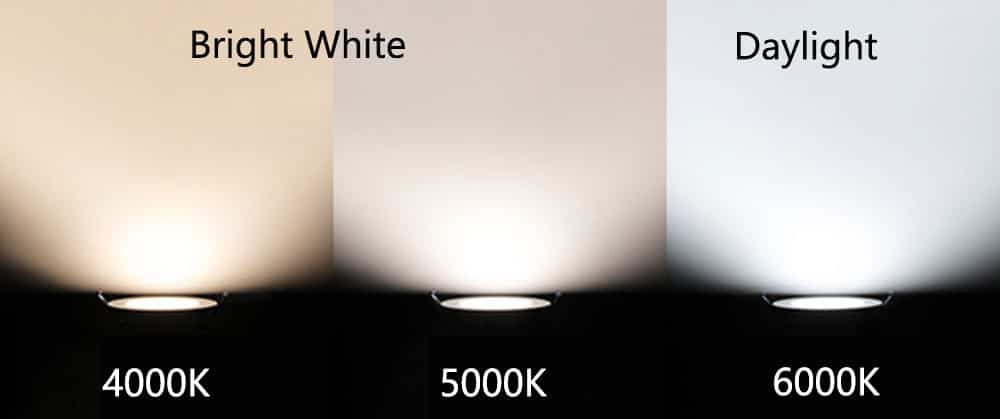
Cool White vs Daylight
Definition and Characteristics:
Cool White Light:
Color Temperature: 4000K to 6500K.
Visual Appearance: Provides a modern, clean, and crisp lighting effect.
Applications: Suitable for office spaces, retail outlets, and any areas requiring clear and bright lighting.
Daylight:
Color Temperature: 5000K to 6500K.
Visual Appearance: Mimics natural daylight, offering a crisp, invigorating light that’s ideal for enhancing focus and productivity.
Applications: Perfect for workspaces, studios, and garages, or any task-oriented environments.
Comparative Analysis:
Color Temperature: Both cool white and daylight fall within a similar color temperature range, but daylight tends to be at the higher end of the spectrum, offering a light that’s closest to natural daylight.
Visual Appearance: Cool white light provides a neutral, bright light, while daylight offers a more natural-looking bright light that’s energizing and invigorating.
Applications: Cool white is versatile for various commercial and residential settings, while daylight is particularly suited for task-oriented spaces.
Suitable Applications:
Residential Spaces:
Cool white is ideal for kitchens, bathrooms, and home offices.
Daylight is suitable for areas requiring clear, bright light such as home offices and garages.
Commercial Spaces:
Cool white is a popular choice for retail spaces, offices, and other commercial areas requiring bright, clear lighting.
Daylight is preferred in workspaces, studios, and other task-oriented spaces where natural-looking bright light is beneficial.
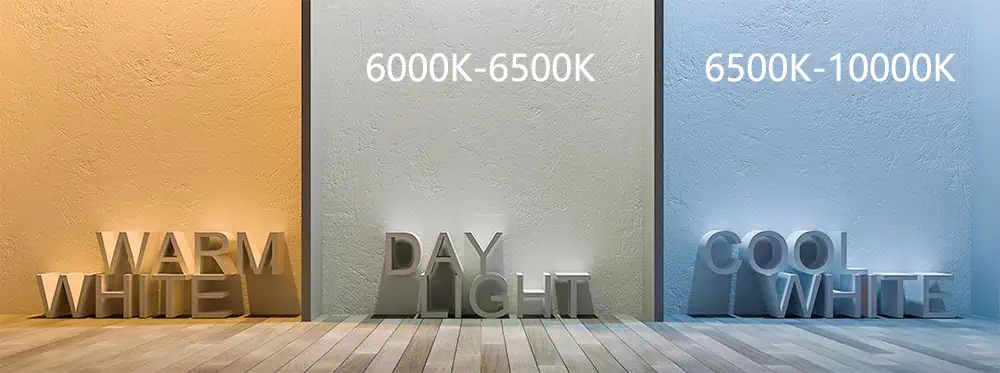
Soft White vs Bright White
Definition and Characteristics:
Soft White Light:
Color Temperature: 2700K to 3000K.
Visual Appearance: Provides a cozy, warm, and inviting ambiance with a yellowish hue.
Applications: Ideal for living rooms, bedrooms, and any area where a relaxed and comfortable atmosphere is desired.
Bright White Light:
Color Temperature: 3200K to 4000K.
Visual Appearance: Offers a neutral and balanced white light that’s clean and modern.
Applications: Suitable for kitchens, bathrooms, offices, and commercial spaces requiring a neutral lighting atmosphere.
Comparative Analysis:
Color Temperature: The color temperature of soft white light is warmer, providing a cozy ambiance, while bright white light has a cooler temperature offering a neutral ambiance.
Visual Appearance: Soft white light has a yellowish hue creating a warm and cozy atmosphere, while bright white light is more balanced and neutral, suitable for a clear and modern look.
Applications: Soft white light is preferred in living and sleeping areas for its cozy ambiance, whereas bright white light is preferred in working areas and commercial spaces for its neutral and clear lighting.
Suitable Applications:
Residential Spaces:
Soft white light is ideal for bedrooms, living rooms, and dining areas.
Bright white light is suitable for home offices, kitchens, and bathrooms.
Commercial Spaces:
Bright white light is ideal for office spaces, retail stores, and other commercial areas where a clear, neutral light is beneficial.
Cool White vs Bright White
Definition and Characteristics:
Cool White Light:
Color Temperature: 4000K to 6500K.
Visual Appearance: Bright and vibrant, leaning towards a blue hue.
Applications: Suitable for office spaces, retail outlets, and task-oriented areas.
Bright White Light:
Color Temperature: 3200K to 4000K.
Visual Appearance: Neutral and balanced, creating a clean, modern look.
Applications: Ideal for kitchens, bathrooms, offices, and commercial spaces.
Comparative Analysis:
Color Temperature: Cool white light has a higher color temperature compared to bright white light, indicating a cooler light.
Visual Appearance: Cool white is brighter and more vibrant, while bright white is neutral and balanced.
Applications: Cool white is more suited for task-oriented and commercial spaces, while bright white is versatile and works well in both residential and commercial settings.
Suitable Applications:
Residential Spaces:
Bright white is ideal for kitchens, bathrooms, and home offices.
Cool white is suitable for garages, workshops, or any areas requiring bright, clear light.
Commercial Spaces:
Both cool white and bright white are suitable for modern retail spaces, offices, and other commercial areas requiring clear lighting.
Cool White vs Neutral White
Definition and Characteristics:
Cool White Light:
Color Temperature: 4000K to 6500K.
Visual Appearance: Bright, vibrant white light with a hint of blue.
Applications: Suitable for task-oriented spaces, office environments, and retail.
Neutral White Light:
Color Temperature: 3200K to 4000K.
Visual Appearance: Balanced, neutral white light without any noticeable yellow or blue hue.
Applications: Ideal for both residential and commercial spaces where a balanced, neutral lighting is required.
Comparative Analysis:
Color Temperature: Cool white light has a higher color temperature, making it cooler compared to the balanced color temperature of neutral white light.
Visual Appearance: Cool white light has a vibrant, bright appearance with a hint of blue, while neutral white light provides a balanced, neutral illumination without any noticeable hue.
Applications: Cool white light is more suited for task-oriented spaces, while neutral white light’s balanced illumination is versatile for various applications.
Suitable Applications:
Residential Spaces:
Neutral white light is suitable for almost all rooms due to its balanced illumination.
Cool white light is suitable for areas requiring bright lighting like home offices or garages.
Commercial Spaces:
Cool white light is ideal for modern retail spaces, offices, or any commercial areas requiring clear, vibrant lighting.
Neutral white light is suitable for spaces where a balanced, neutral ambiance is preferred.
Color Temperature Adjusting LED Strips (Warm to Cool)
Color temperature-adjusting LED strips, also known as tunable white or dim-to-warm LED strips. They offer a range of warm-to-cool white light options to suit different lighting needs.
Tunable white LED strips typically have a range of color temperatures. From warm white (2700K) to cool white (6500K) and everything in between. This allows users to choose the ideal color temperature for their space. It can be cozy, warm, or bright, cool light.
The color temperature of the LED strip is controlled through a remote or a mobile app. You can adjust the color temperature to suit their needs. Or even you can set up custom color temperature schedules that change throughout the day.
Tunable white LED strips are often used in residential and commercial lighting applications. For example, homes, offices, restaurants, and retail stores. They are also popular in photography and videography applications. Adjusting the color temperature can be essential for achieving the desired look and feel. To know more about this, check out Tunable White LED Strip: The Complete Guide.
Dim-to-warm LED strips are specific color temperature-adjusting LED strips. It mimics the warm glow of incandescent light bulbs when dimmed. As you dim the LED strip, the color temperature gradually shifts from cool white to warm white. Thus creating a cozy and inviting atmosphere.
Different warm tones can be achieved by selecting a specific color temperature range for the LED strip. For example, a color temperature of 2200K-2700K produces a soft, warm glow similar to candlelight. At the same time, a range of 3000K-3500K produces a more neutral warm light.
Overall, color temperature-adjusting dim-to-warm LED strips provide a customizable lighting solution that can suit the needs of any space. Check this out to learn more about dim-to-warm LED strips- Dim To Warm – What It Is and How Does It Work?
FAQs
Yes, the color temperature of LED lights can be adjusted using dimmer switches. Or you can select bulbs with adjustable color temperature settings.
Warm lighting can create a cozy and relaxing atmosphere in a room. It can also enhance the warmth of colors in the space and make the room feel more welcoming.
Using warm light in residential settings can create a comfortable and inviting environment. It can also be beneficial for promoting relaxation and improving sleep quality.
The color temperature for natural white lighting is typically around 4000-5000 Kelvin (K).
Cool light can improve alertness and focus in work environments. It can also create a brighter and more stimulating atmosphere. This can be helpful for tasks that require attention to detail.
Cool light can create a bright and energizing atmosphere in commercial settings. It can promote productivity and alertness. It can also help create a more professional appearance.
A cooler light with a color temperature of around 5000-6500K is generally recommended for reading. It can help improve focus and reduce eye strain. However, some people may prefer a warmer light (2700K – 3000K) for reading as it can create a more relaxed atmosphere.
Yes, the color temperature of LED lights can be adjusted. Many LED lights come with color temperature adjustment options. It allows you to switch between warm, neutral, and cool lighting. For example, tunable LED lights.
Warm light enhances warm colors such as reds, oranges, and yellows. Cool light can enhance cooler colors like blues, greens, and purples. As a result, the same object may appear differently under different lighting conditions.
The project’s unique requirements determine this. Still, warm light is generally better for photography. But, for high-contrast videography, cool color provides a more balanced color rendition.
Yes, it is possible to have both warm and cool lighting in the same room. For example- using Tunable White LED strips allows you to adjust the color temperature of lights from warm to cool. This can be useful for creating different moods or highlighting different areas of the space.
The cost of warm and cool Light bulbs can vary depending on the brand and type of bulb. However, there is generally no significant cost difference between warm and cool light. Bulbs with the same wattage and specifications can cost the same.
Yes, using the wrong type of light can impact sleep quality. Exposure to cool light in the evening can disrupt the body’s natural sleep-wake cycle. And make it more difficult to fall asleep.
One common misconception is that warm light is always better for residential settings. And cool light is always better for commercial settings. However, the best type of light for a space depends on various factors. This includes the specific needs and preferences of the individuals using the space.
Yes, using the wrong type of light can cause eye strain and headaches, mainly if the lighting is too dim, bright, or cool.
Final Thoughts
The debut between warm and cool lighting will keep going as both the lighting are excellent in their respective places. While warm light may evoke feelings of comfort and intimacy. Cool light can promote productivity and a sense of alertness. Ultimately, the choice between the two may come down to personal preference and the intended use of the lighting.
Whether you prefer the cozy glow of a warm light or the energizing brightness of a cool light, LED lighting plays a crucial role in setting the tone and atmosphere of any space. In LEDYi, we provide exceptional quality LED strip lights suitable for indoors and outdoors. We have tunable white LED strips and dim-to-warm LED strips for warm and cool lighting. These strip lights have a smart controller to adjust the color temperature according to your mood. Besides warm and cool adjustable lighting, we also have a single color, RGB, and addressable LED strips.
So, go ahead and experiment with lighting from our website. Here you will find the perfect balance for your needs and enjoy the many benefits of a well-lit environment.


